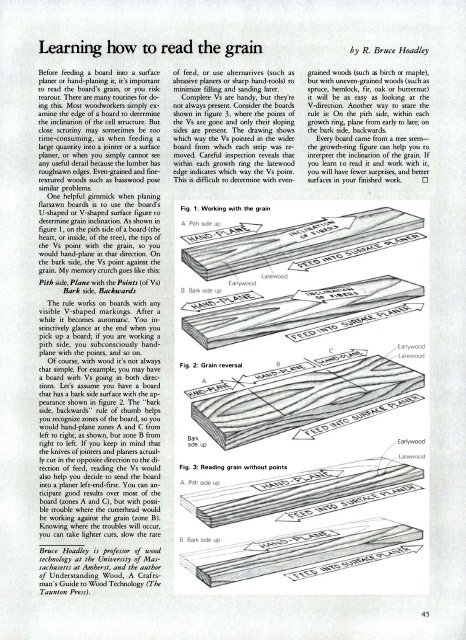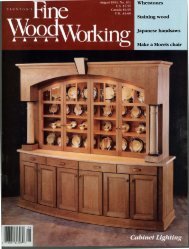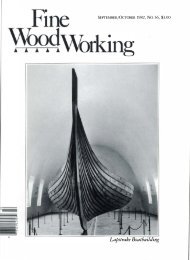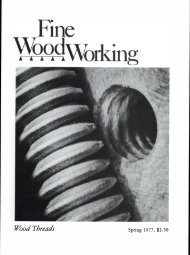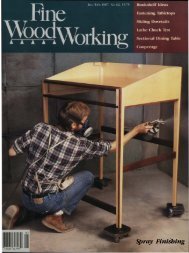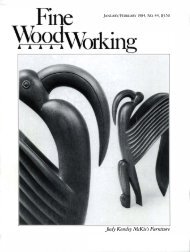NOVEMBER/DECEMBER 1983, No. 43, $3.50 Making ... - Wood Tools
NOVEMBER/DECEMBER 1983, No. 43, $3.50 Making ... - Wood Tools
NOVEMBER/DECEMBER 1983, No. 43, $3.50 Making ... - Wood Tools
Create successful ePaper yourself
Turn your PDF publications into a flip-book with our unique Google optimized e-Paper software.
Learning how to read the grain<br />
Before feeding a board into a surface<br />
planer or hand-planing it, it's important<br />
to read the board's grain, or you risk<br />
tearout. There are many routines for doing<br />
this. Most woodworkers simply examine<br />
the edge of a board to determine<br />
the inclination of the cell structure. But<br />
close scrutiny may sometimes be too<br />
time-consuming, as when feeding a<br />
large quantity into a jointer or a surface<br />
planer, or when you simply cannot see<br />
any useful detail because the lumber has<br />
roughsawn edges. Even-grained and fmetextured<br />
woods such as basswood pose<br />
similar problems.<br />
One helpful gimmick when planing<br />
flatsawn boards is to use the board's<br />
U-shaped or V-shaped surface figure to<br />
determine grain inclination. As shown in<br />
figure 1, on the pith side of a board (the<br />
heart, or inside, of the tree), the tips of<br />
the Vs point with the grain, so you<br />
would hand-plane in that direction. On<br />
the bark side, the Vs point against the<br />
grain. My memory crutch goes like this:<br />
Pith side, Plane with the Points (of Vs)<br />
Bark side, Backwards<br />
The rule works on boards with any<br />
visible V -shaped markings. After a<br />
while it becomes automatic. You instinctively<br />
glance at the end when you<br />
pick up a board; if you are working a<br />
pith side, you subconsciously handplane<br />
with the points, and so on.<br />
Of course, with wood it's not always<br />
that simple. For example, you may have<br />
a board with Vs going in both directions.<br />
Let's assume you have a board<br />
that has a bark side surface with the appearance<br />
shown in figure 2. The "bark<br />
side, backwards" rule of thumb helps<br />
you recognize zones of the board, so you<br />
would hand-plane zones A and C from<br />
left to right, as shown, but zone B from<br />
right to left. If you keep in mind that<br />
the knives of jointers and planers actually<br />
cut in the opposite direction to the direction<br />
of feed, reading the Vs would<br />
also help you decide to send the board<br />
into a planer left-end-first. You can anticipate<br />
good results over most of the<br />
board (zones A and C), but with possible<br />
trouble where the cutterhead would<br />
be working against the grain (zone B).<br />
Knowing where the troubles will occur,<br />
you can take lighter cuts, slow the rate<br />
Bruce Hoadley is professor of wood<br />
technology at the University of Massachusetts<br />
at Amherst, and the author<br />
of Understanding <strong>Wood</strong>, A Craftsman's<br />
Guide to <strong>Wood</strong> Technology (The<br />
Taunton Press) .<br />
of feed, or use alternatives (such as<br />
abrasive planers or sharp hand-tools) to<br />
minimize filling and sanding later.<br />
Complete Vs are handy, but they're<br />
not always present. Consider the boards<br />
shown in figure 3, where the points of<br />
the Vs are gone and only their sloping<br />
sides are present. The drawing shows<br />
which way the Vs pointed in the wider<br />
board from which each strip was removed.<br />
Careful inspection reveals that<br />
within each growth ring the latewood<br />
edge indicates which way the Vs point.<br />
This is difficult to determine with even-<br />
Fig. 1: Working with the grain<br />
Fig. 2: Grain reversal<br />
Bark<br />
side up<br />
Fig. 3: Reading grain without points<br />
A.<br />
��;:::Z�<br />
B. Bark s ide up<br />
by R. Bruce Hoadley<br />
grained woods (such as birch or maple),<br />
but with uneven-grained woods (such as<br />
spruce, hemlock, fir, oak or butternut)<br />
it will be as easy as looking at the<br />
V-direction. Another way to state the<br />
rule is: On the pith side, within each<br />
growth ring, plane from early to late; on<br />
the bark side, backwards.<br />
Every board came from a tree stemthe<br />
growth-ring figure can help you to<br />
interpret the inclination of the grain. If<br />
you learn to read it and work with it,<br />
you will have fewer surprises, and better<br />
surfaces in your finished work. 0<br />
Earlywood<br />
Earlywood<br />
45


